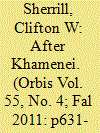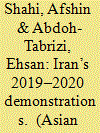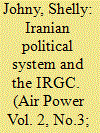| Srl | Item |
| 1 |
ID:
106886


|
|
|
|
|
| Publication |
2011.
|
| Summary/Abstract |
Since succeeding the Supreme Leader Ayatollah Khomeini in 1989, Ali Khamenei has striven to make himself indispensible to the fate of Islamic fundamentalism in Iran. However, the measures Khamenei has taken to secure his power have left his succession in doubt, with no consensus heir. The lack of clear successors among the clergy, weakness of the government institutions, and concerns about regime strength could lead to instability and the potential for an Islamic Revolution Guard Corps coup.
|
|
|
|
|
|
|
|
|
|
|
|
|
|
|
|
| 2 |
ID:
191800


|
|
|
|
|
| Summary/Abstract |
The Islamic Revolutionary Guards Corps (IRGC) played a significant role in repressing armed movements that erupted around Iran after the 1979 revolution, but little is known about how this repression campaign shaped the IRGC’s organization and logic of practice. Focusing on the most intensive of these movements, i.e. the Iranian Kurdish conflict at its height in 1979–80, this article argues that the IRGC’s involvement in the conflict ingrained a particular structure and practice within it, in two ways. On the political level, fighting for the state legitimized the IRGC’s existence as an organization independent of the regular army. On an organizational level, learning combat in a low-intensity war allowed the IRGC to adopt a flexible structure based on direct action, which was attractive to both leaders and volunteers as the ‘revolutionary’ method. I argue that post-revolutionary civil conflicts enable alternative paths of institution-building by defying the need for rapid centralization. The article uses novel in-depth interviews with veterans of the Islamic Revolutionary Guards Corps and Iranian Army officers, as well as documents collected in Iran, to explore this early phase of the IRGC’s history.
|
|
|
|
|
|
|
|
|
|
|
|
|
|
|
|
| 3 |
ID:
171870


|
|
|
|
|
| Summary/Abstract |
The widespread protests of November 2019 may be marked as the bloodiest recent chapter of the Islamic Republic of Iran's history in terms of popular dissent. The two major protests in December 2017 and November 2019, followed by the public reaction to the shooting down of the Ukrainian International Airlines Flight 752 by the IRGC over Tehran after the US killing of General Soleimani, suggest that the prevailing dynamics of political protest in Iran are changing. There is an increasing sense of radicalisation among protesters, while the state is prepared to resort to extreme violence to maintain control. The geography of political protest has changed. The declining economic situation has had a profound impact on the more vulnerable segments of the society who are now increasingly playing a more proactive role in challenging the state. The methods of protest have been evolving over the last four decades, especially in the cultural arena. Last but not least, the willingness of the protesters both to endure and inflict violence is precipitously transforming state-society relations beyond recognition.
|
|
|
|
|
|
|
|
|
|
|
|
|
|
|
|
| 4 |
ID:
079056


|
|
|
| 5 |
ID:
141315


|
|
|
|
|
| Summary/Abstract |
Iran’s domestic politics and power structure have been a source of puzzlement and conjecture since the country’s 1979 revolution, which toppled a U.S. ally and brought the Islamic Republic to power. This bewilderment intensified during the nuclear negotiations between six world powers collectively known as the P5+1 (China, France, Germany, Russia, the United Kingdom, and the United States) and Tehran.
|
|
|
|
|
|
|
|
|
|
|
|
|
|
|
|
| 6 |
ID:
126743


|
|
|
|
|
| Publication |
New Delhi, Institute for Defence Studies and Analyses, 2013.
|
| Description |
80p.Pbk
|
| Series |
IDSA Monograph Series No.28
|
| Standard Number |
9789382169284
|
|
|
|
|
|
|
|
|
|
|
|
Copies: C:2/I:0,R:0,Q:0
Circulation
| Accession# | Call# | Current Location | Status | Policy | Location |
| 057537 | 320.955/RIZ 057537 | Main | On Shelf | General | |
| 057538 | 320.955/RIZ 057538 | Main | On Shelf | General | |
|
|
|
|